Transportation and logistics modeling 2
Download as pptx, pdf0 likes356 views
This document discusses statistical concepts like variability, random experiments, descriptive statistics, probability distributions, and statistical data analysis. It provides examples of different probability distributions like binomial, Poisson, normal, exponential, and Weibull distributions. It also discusses the four basic steps of statistical data analysis: defining the problem, collecting the data, analyzing the data, and reporting results. Methods like hypothesis testing are discussed as part of data analysis.
1 of 47
Downloaded 13 times
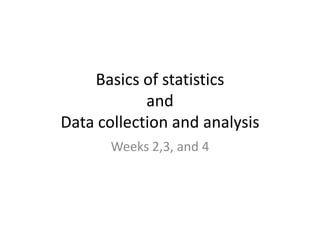
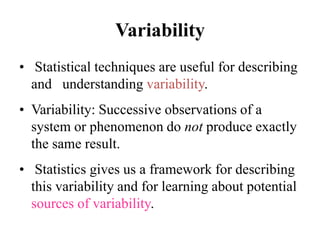

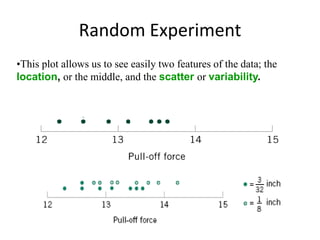
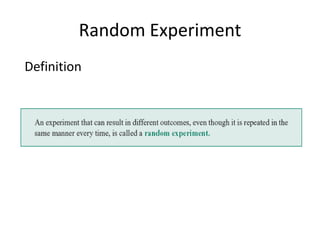

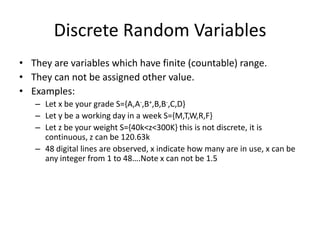

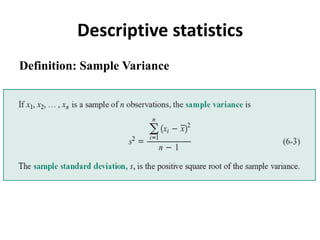

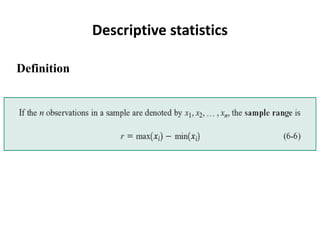


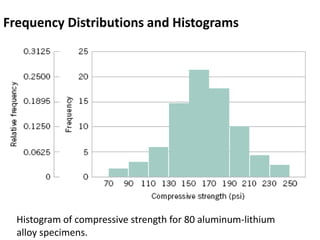
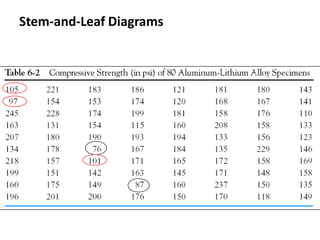

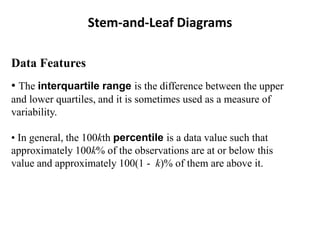
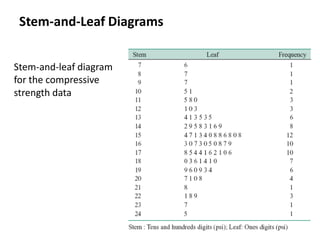

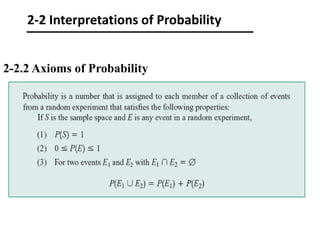
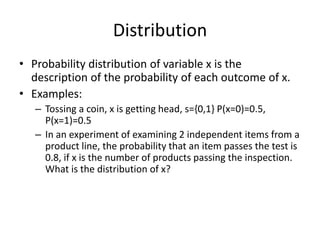
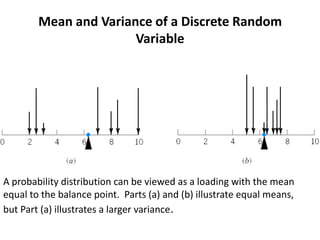

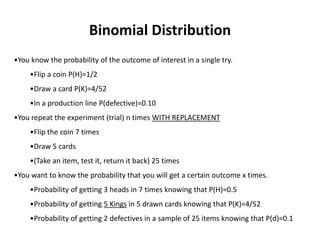

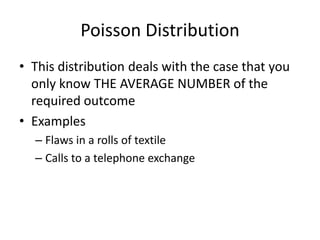

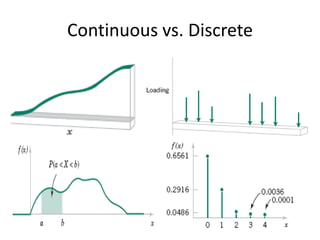

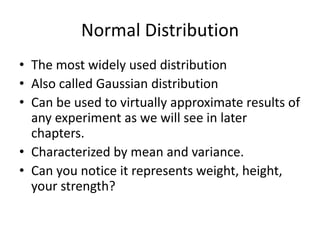

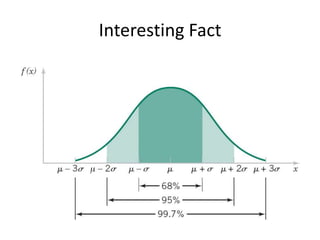

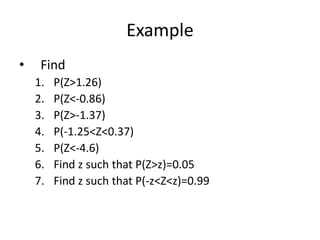

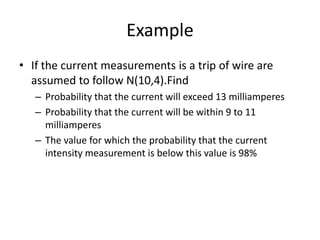


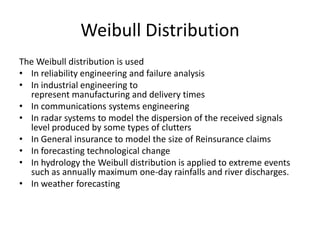
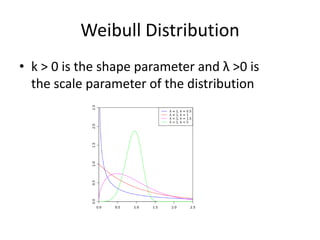
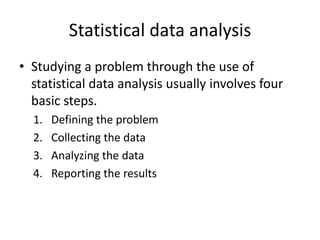
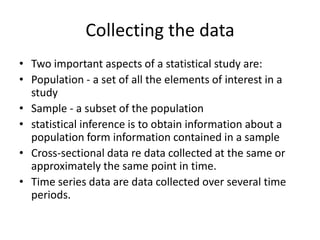


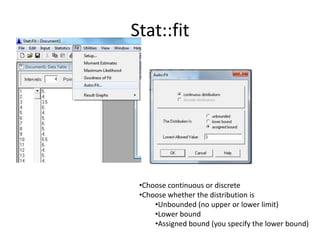
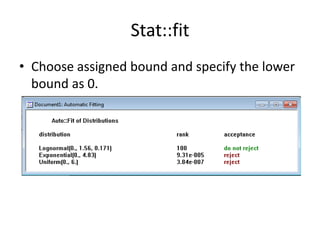
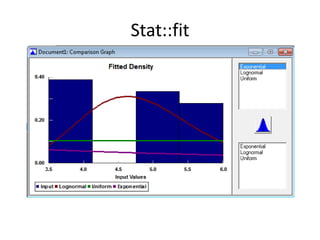
Ad
Recommended
Graphs that Enlighten and Graphs that Deceive
Graphs that Enlighten and Graphs that DeceiveLong Beach City College
╠²
Chapter 2 of the elementary statistics document covers various methods to explore data using tables and graphs, including frequency distributions, histograms, and different types of plots such as scatter plots and stemplots. It discusses both enlightening and deceptive graphical representations, emphasizing the importance of appropriate scaling and representation to avoid misleading interpretations of data. The chapter also includes various examples demonstrating how to construct different graphs and interpret their results.Chapter03
Chapter03rwmiller
╠²
The document discusses various graphical methods for describing data, including bar charts, pie charts, stem-and-leaf diagrams, histograms, and cumulative relative frequency plots. It provides examples of each using sample student data on vision correction, weights, ages, and GPAs to illustrate how to construct and interpret the different graph types.Chapter 3
Chapter 3guest3720ca
╠²
This document provides an overview of key concepts in descriptive statistics including:
- Parameters describe populations while statistics describe samples
- Measures of central tendency include the mean, median, and mode
- Measures of variation/dispersion include range, variance, standard deviation, and coefficient of variation
- The empirical rule and Chebyshev's theorem describe how data is distributed around the mean
- Z-scores and percentiles relate individual values to the overall distributionHcai 5220 lecture notes on campus sessions fall 11(2)
Hcai 5220 lecture notes on campus sessions fall 11(2)Twene Peter
╠²
This chapter discusses descriptive statistics such as measures of central tendency (mean, median, mode), measures of variation (range, variance, standard deviation, coefficient of variation), and the shape of distributions (skewness). It also covers the normal distribution and how to calculate probabilities using the normal distribution. Key points include:
1) The mean, median, and mode are measures of central tendency while the range, variance, standard deviation, and coefficient of variation measure the spread or variation of data.
2) The normal distribution is a bell-shaped symmetric distribution that is useful in inferential statistics.
3) Probabilities using the normal distribution can be calculated by transforming the data into standard normal variables (ZHistogram
HistogramMohit Singla
╠²
A histogram is a graphical display of data using bars of different heights. It organizes and displays the distribution of data values or ranges of data. The document discusses what a histogram is, why there is variation in data, how to construct a histogram, and key elements to study like location, spread, and shape of the data distribution. To construct a histogram, you need the minimum and maximum values, number of cells, class width, and lower boundaries of each class. This allows plotting the frequency distribution in a visual way.Chapter01
Chapter01rwmiller
╠²
The document discusses the importance and key concepts of statistics. It introduces three main reasons to study statistics: to be an informed consumer of information, to understand and make decisions, and to evaluate decisions that affect one's life. It then defines important statistical terms like population, sample, variable, and data types. It also provides examples of different data sets and ways to organize data, such as through frequency distributions, bar charts, and dot plots.Chapter 2 250110 083240
Chapter 2 250110 083240guest25d353
╠²
This document discusses frequency distributions and graphs. It defines frequency distributions as organizing raw data into a table using classes and frequencies. There are three main types: categorical, grouped, and ungrouped. Guidelines are provided for constructing frequency distributions, such as having 5-20 classes of equal width. Common graphs discussed are histograms, frequency polygons, ogives, Pareto charts, time series graphs, and pie charts. These graphs represent frequency distributions in visual formats.Measures of Relative Standing and Boxplots
Measures of Relative Standing and BoxplotsLong Beach City College
╠²
Chapter 3 discusses various statistical measures for describing, exploring, and comparing data, focusing on central tendency, variation, and relative standing using techniques like z-scores, percentiles, and quartiles. It emphasizes the use of boxplots and five-number summaries to visualize data distribution, identify outliers, and understand data skewness. Key concepts include calculating measures like the mean, median, mode, and employing formulas for z-scores and percentiles to assess individual data values' positions within a dataset.Two variances or standard deviations
Two variances or standard deviations Long Beach City College
╠²
This document provides information about statistical tests that can be used to make inferences when comparing two samples or populations. Specifically, it discusses:
- Tests for comparing two proportions, means, variances or standard deviations from independent and dependent samples using z-tests, t-tests and F-tests.
- The assumptions and procedures for each test, including how to determine critical values and calculate test statistics.
- Examples of how to perform hypothesis tests and construct confidence intervals for various statistical comparisons between two samples or populations using a TI calculator.What is a histogram
What is a histogramElmer Lapi-an
╠²
A histogram is a graphical representation of a frequency distribution of numerical data, using bars of different heights. It groups data into ranges called bins and plots the number of data points in each bin. The example document shows a simple histogram for a data set of numbers from 1 to 6, and discusses how real histograms are made by binning continuous data into convenient ranges. It also discusses how the shape of a histogram can provide information about the distribution of data points around the mean and median, and how multiple peaks may indicate separate signals in the data.Chapter12
Chapter12rwmiller
╠²
The document discusses goodness-of-fit tests for categorical data. It introduces notation for categorical variables with multiple categories and hypotheses for goodness-of-fit tests. Expected counts are calculated based on hypothesized proportions. The chi-square statistic is used to calculate test statistics and P-values are found using the chi-square distribution. Examples demonstrate applying goodness-of-fit tests to determine if variable categories occur with equal frequency.Descriptive Statistics - Thiyagu K
Descriptive Statistics - Thiyagu KThiyagu K
╠²
The document outlines key concepts in descriptive statistics related to quantitative variables, focusing on measures of central tendency, variability, and distribution shape. It details methods for assessing normality, including the Kolmogorov-Smirnov and Shapiro-Wilk tests, and explains various visualizations for data analysis such as histograms and box plots. Additionally, it provides guidelines for using SPSS software for statistical analysis and interpreting the results related to data distribution.Descriptive Statistics
Descriptive StatisticsBhagya Silva
╠²
This document discusses descriptive statistics and analysis. It provides definitions of key terms like data, variable, statistic, and parameter. It also describes common measures of central tendency like mean, median and mode. Additionally, it covers measures of variability such as range, variance and standard deviation. Various graphical and numerical methods for summarizing and presenting sample data are presented, including tables, charts and distributions.1.8 discretization
1.8 discretizationKrish_ver2
╠²
1. Discretization involves dividing the range of continuous attributes into intervals to reduce data size. Concept hierarchy formation recursively groups low-level concepts like numeric values into higher-level concepts like age groups.
2. Common techniques for discretization and concept hierarchy generation include binning, histogram analysis, clustering analysis, and entropy-based discretization. These techniques can be applied recursively to generate hierarchies.
3. Discretization and concept hierarchies reduce data size, provide more meaningful interpretations, and make data mining and analysis easier.Lecture 03.
Lecture 03.AlfahadFarwa
╠²
The document discusses various methods for presenting data in statistics, such as frequency tables, bar diagrams, and histograms, emphasizing the importance of organizing and summarizing numbers for easier comprehension. It explains the construction of frequency distributions, including determining class intervals, class boundaries, and midpoints. Practical examples are provided to illustrate the process of creating a frequency distribution from a data set.Measurement and descriptive statistics
Measurement and descriptive statisticsPhß║Īm Ph├║c Kh├Īnh Minh
╠²
This document discusses measurement and descriptive statistics. It defines different levels of measurement including nominal, ordinal, interval and ratio scales. It also describes various descriptive statistics and plots used to summarize data such as frequency tables, bar charts, histograms, frequency polygons, box and whisker plots, measures of central tendency (mean, median, mode), and measures of variability (range, standard deviation, interquartile range). The key points are that different statistical analyses require different levels of measurement and that descriptive statistics and plots are used to describe and visualize the distribution of values in a dataset.Business statistics-i-part2-aarhus-bss
Business statistics-i-part2-aarhus-bssAntonio Rivero Ostoic
╠²
This document provides an overview of lectures for a business statistics course covering weeks 43-50. It discusses key concepts in estimation including:
- Point and interval estimators for population parameters based on sample statistics
- Properties of unbiased and consistent estimators
- How to construct confidence intervals for estimating the population mean when the standard deviation is known, including interpreting the results.
- How sample size affects the width of confidence intervals and precision of estimates.Chapter 2
Chapter 2guest3720ca
╠²
This document discusses different types of graphs and distributions that can be used to organize and represent data. It covers frequency distributions, histograms, frequency polygons, ogives, relative frequency graphs, Pareto charts, time series graphs, pie charts, and stem-and-leaf plots. Rules for constructing frequency distributions are provided, such as having between 5-20 classes and equal class widths. Examples are given to illustrate each type of graph or distribution.Chapter02
Chapter02rwmiller
╠²
The document discusses key concepts in data analysis including variables, data, data sets, sampling methods, bias, experiments, and experimental design. It defines important terms like variable, data, univariate and multivariate data sets. It also covers types of sampling methods like simple random sampling, stratified sampling, cluster sampling, systematic sampling and convenience sampling. Experimental design principles like randomization, blocking, and replication are also summarized.Chapter11
Chapter11rwmiller
╠²
The document discusses hypothesis testing methods for comparing two population or treatment means. It covers notation, sampling distributions, large sample hypothesis testing, confidence intervals, and paired t-tests. An example compares the mean fill volumes of two beer can filling machines and constructs a 98% confidence interval for the difference in tensile strengths of two thread types.Small Sampling Theory Presentation1
Small Sampling Theory Presentation1jravish
╠²
Small sample theory deals with statistical inference when sample sizes are small (n Ōēż 30). It involves t and F distributions which are defined in terms of degrees of freedom. The t-distribution was developed by William Gosset and is used when sample sizes are small. It has a bell shape but is more spread out than the normal distribution. The F-distribution is used to test if two variances are equal and is defined as the ratio of two chi-square variables. Both distributions depend on degrees of freedom.Chapter15
Chapter15rwmiller
╠²
A study examined the survival times of cancer patients treated with ascorbate based on the affected organ. A one-way ANOVA was conducted to determine if survival times differed significantly between stomach, bronchus, colon, ovary and breast cancer patients. The ANOVA indicated that at least two of the survival time means were significantly different. Post-hoc multiple comparisons were needed to identify which specific organ means differed from each other.15. descriptive statistics
15. descriptive statisticsAshok Kulkarni
╠²
This document discusses descriptive statistics and how they are used to summarize raw data. Descriptive statistics include rates, ratios, proportions, measures of central tendency (mean, median, mode), variation (standard deviation), and position (percentiles, quartiles). These statistics can be presented numerically and graphically using tables, bar charts, pie charts, histograms, box plots, and scatter plots. Software like MS Excel is commonly used to calculate descriptive statistics and generate graphs to meaningfully reduce and present large amounts of raw data.STATISTIC ESTIMATION
STATISTIC ESTIMATIONSmruti Ranjan Parida
╠²
This document provides an overview of statistical inference. It discusses descriptive statistics, which summarize data, and inferential statistics, which are used to generalize from samples to populations. Key concepts covered include estimation, hypothesis testing, parameters, statistics, confidence intervals, significance levels, types of errors. Examples are given of how to calculate confidence intervals for means and proportions and how to perform hypothesis tests using z-tests and t-tests. Steps for conducting hypothesis tests are outlined.Bbs10 ppt ch03
Bbs10 ppt ch03Anwar Afridi
╠²
This document provides an overview of key concepts in descriptive statistics that are covered in Chapter 3, including measures of central tendency, variation, and shape. It introduces the mean, median, mode, variance, standard deviation, range, interquartile range, and coefficient of variation as common statistical measures used to describe the properties of numerical data. Examples are given to demonstrate how to calculate and interpret these descriptive statistics. The chapter aims to help readers learn how to calculate summary measures for a population and construct graphical displays like box-and-whisker plots.Measures of Variation
Measures of Variation Long Beach City College
╠²
Chapter 3 of elementary statistics focuses on describing, exploring, and comparing data, emphasizing measures of variation such as range, variance, and standard deviation. It outlines objectives for summarizing data and understanding the significance of variation in statistics. Key concepts include the empirical rule, ChebyshevŌĆÖs theorem, and coefficients of variation for comparing datasets.Chapter 11 Psrm
Chapter 11 Psrmmandrewmartin
╠²
This document provides an overview of key concepts in descriptive statistics including measures of central tendency (mode, median, mean), measures of dispersion (range, variance, standard deviation), the normal distribution, z-scores, hypothesis testing, and the t-distribution. It defines each concept and provides examples of calculating and interpreting common statistics.2. chapter ii(analyz)
2. chapter ii(analyz)Chhom Karath
╠²
Frequencies provides statistics and graphical displays to describe variables. It can order values by ascending/descending order or frequency. Key outputs include mean, median, mode, quartiles, standard deviation, variance, skewness, and kurtosis. Quartiles divide data into four equal groups. Skewness measures asymmetry while kurtosis measures clustering around the mean. Charts like pie charts, bar charts, and histograms can visualize the data distribution. Crosstabs forms two-way and multi-way tables to analyze relationships between variables.Statistics
Statisticspikuoec
╠²
This document provides an overview of key concepts in statistics including:
- Descriptive statistics such as frequency distributions which organize and summarize data
- Inferential statistics which make estimates or predictions about populations based on samples
- Types of variables including quantitative, qualitative, discrete and continuous
- Levels of measurement including nominal, ordinal, interval and ratio
- Common measures of central tendency (mean, median, mode) and dispersion (range, standard deviation)MEASURES OF DISPERSION I BSc Botany .ppt
MEASURES OF DISPERSION I BSc Botany .pptaigil2
╠²
This document discusses various statistical measures of dispersion. It defines dispersion as how spread out or varied a set of numerical data is from the average value. There are two types of measures - absolute, which have the same units as the data, and relative, which are unit-less and used to compare datasets. Examples of measures discussed include range, mean deviation, standard deviation, variance, and coefficient of variation. The document also covers frequency distributions, binomial distributions, chi-square tests, and data analysis processes.More Related Content
What's hot (19)
Two variances or standard deviations
Two variances or standard deviations Long Beach City College
╠²
This document provides information about statistical tests that can be used to make inferences when comparing two samples or populations. Specifically, it discusses:
- Tests for comparing two proportions, means, variances or standard deviations from independent and dependent samples using z-tests, t-tests and F-tests.
- The assumptions and procedures for each test, including how to determine critical values and calculate test statistics.
- Examples of how to perform hypothesis tests and construct confidence intervals for various statistical comparisons between two samples or populations using a TI calculator.What is a histogram
What is a histogramElmer Lapi-an
╠²
A histogram is a graphical representation of a frequency distribution of numerical data, using bars of different heights. It groups data into ranges called bins and plots the number of data points in each bin. The example document shows a simple histogram for a data set of numbers from 1 to 6, and discusses how real histograms are made by binning continuous data into convenient ranges. It also discusses how the shape of a histogram can provide information about the distribution of data points around the mean and median, and how multiple peaks may indicate separate signals in the data.Chapter12
Chapter12rwmiller
╠²
The document discusses goodness-of-fit tests for categorical data. It introduces notation for categorical variables with multiple categories and hypotheses for goodness-of-fit tests. Expected counts are calculated based on hypothesized proportions. The chi-square statistic is used to calculate test statistics and P-values are found using the chi-square distribution. Examples demonstrate applying goodness-of-fit tests to determine if variable categories occur with equal frequency.Descriptive Statistics - Thiyagu K
Descriptive Statistics - Thiyagu KThiyagu K
╠²
The document outlines key concepts in descriptive statistics related to quantitative variables, focusing on measures of central tendency, variability, and distribution shape. It details methods for assessing normality, including the Kolmogorov-Smirnov and Shapiro-Wilk tests, and explains various visualizations for data analysis such as histograms and box plots. Additionally, it provides guidelines for using SPSS software for statistical analysis and interpreting the results related to data distribution.Descriptive Statistics
Descriptive StatisticsBhagya Silva
╠²
This document discusses descriptive statistics and analysis. It provides definitions of key terms like data, variable, statistic, and parameter. It also describes common measures of central tendency like mean, median and mode. Additionally, it covers measures of variability such as range, variance and standard deviation. Various graphical and numerical methods for summarizing and presenting sample data are presented, including tables, charts and distributions.1.8 discretization
1.8 discretizationKrish_ver2
╠²
1. Discretization involves dividing the range of continuous attributes into intervals to reduce data size. Concept hierarchy formation recursively groups low-level concepts like numeric values into higher-level concepts like age groups.
2. Common techniques for discretization and concept hierarchy generation include binning, histogram analysis, clustering analysis, and entropy-based discretization. These techniques can be applied recursively to generate hierarchies.
3. Discretization and concept hierarchies reduce data size, provide more meaningful interpretations, and make data mining and analysis easier.Lecture 03.
Lecture 03.AlfahadFarwa
╠²
The document discusses various methods for presenting data in statistics, such as frequency tables, bar diagrams, and histograms, emphasizing the importance of organizing and summarizing numbers for easier comprehension. It explains the construction of frequency distributions, including determining class intervals, class boundaries, and midpoints. Practical examples are provided to illustrate the process of creating a frequency distribution from a data set.Measurement and descriptive statistics
Measurement and descriptive statisticsPhß║Īm Ph├║c Kh├Īnh Minh
╠²
This document discusses measurement and descriptive statistics. It defines different levels of measurement including nominal, ordinal, interval and ratio scales. It also describes various descriptive statistics and plots used to summarize data such as frequency tables, bar charts, histograms, frequency polygons, box and whisker plots, measures of central tendency (mean, median, mode), and measures of variability (range, standard deviation, interquartile range). The key points are that different statistical analyses require different levels of measurement and that descriptive statistics and plots are used to describe and visualize the distribution of values in a dataset.Business statistics-i-part2-aarhus-bss
Business statistics-i-part2-aarhus-bssAntonio Rivero Ostoic
╠²
This document provides an overview of lectures for a business statistics course covering weeks 43-50. It discusses key concepts in estimation including:
- Point and interval estimators for population parameters based on sample statistics
- Properties of unbiased and consistent estimators
- How to construct confidence intervals for estimating the population mean when the standard deviation is known, including interpreting the results.
- How sample size affects the width of confidence intervals and precision of estimates.Chapter 2
Chapter 2guest3720ca
╠²
This document discusses different types of graphs and distributions that can be used to organize and represent data. It covers frequency distributions, histograms, frequency polygons, ogives, relative frequency graphs, Pareto charts, time series graphs, pie charts, and stem-and-leaf plots. Rules for constructing frequency distributions are provided, such as having between 5-20 classes and equal class widths. Examples are given to illustrate each type of graph or distribution.Chapter02
Chapter02rwmiller
╠²
The document discusses key concepts in data analysis including variables, data, data sets, sampling methods, bias, experiments, and experimental design. It defines important terms like variable, data, univariate and multivariate data sets. It also covers types of sampling methods like simple random sampling, stratified sampling, cluster sampling, systematic sampling and convenience sampling. Experimental design principles like randomization, blocking, and replication are also summarized.Chapter11
Chapter11rwmiller
╠²
The document discusses hypothesis testing methods for comparing two population or treatment means. It covers notation, sampling distributions, large sample hypothesis testing, confidence intervals, and paired t-tests. An example compares the mean fill volumes of two beer can filling machines and constructs a 98% confidence interval for the difference in tensile strengths of two thread types.Small Sampling Theory Presentation1
Small Sampling Theory Presentation1jravish
╠²
Small sample theory deals with statistical inference when sample sizes are small (n Ōēż 30). It involves t and F distributions which are defined in terms of degrees of freedom. The t-distribution was developed by William Gosset and is used when sample sizes are small. It has a bell shape but is more spread out than the normal distribution. The F-distribution is used to test if two variances are equal and is defined as the ratio of two chi-square variables. Both distributions depend on degrees of freedom.Chapter15
Chapter15rwmiller
╠²
A study examined the survival times of cancer patients treated with ascorbate based on the affected organ. A one-way ANOVA was conducted to determine if survival times differed significantly between stomach, bronchus, colon, ovary and breast cancer patients. The ANOVA indicated that at least two of the survival time means were significantly different. Post-hoc multiple comparisons were needed to identify which specific organ means differed from each other.15. descriptive statistics
15. descriptive statisticsAshok Kulkarni
╠²
This document discusses descriptive statistics and how they are used to summarize raw data. Descriptive statistics include rates, ratios, proportions, measures of central tendency (mean, median, mode), variation (standard deviation), and position (percentiles, quartiles). These statistics can be presented numerically and graphically using tables, bar charts, pie charts, histograms, box plots, and scatter plots. Software like MS Excel is commonly used to calculate descriptive statistics and generate graphs to meaningfully reduce and present large amounts of raw data.STATISTIC ESTIMATION
STATISTIC ESTIMATIONSmruti Ranjan Parida
╠²
This document provides an overview of statistical inference. It discusses descriptive statistics, which summarize data, and inferential statistics, which are used to generalize from samples to populations. Key concepts covered include estimation, hypothesis testing, parameters, statistics, confidence intervals, significance levels, types of errors. Examples are given of how to calculate confidence intervals for means and proportions and how to perform hypothesis tests using z-tests and t-tests. Steps for conducting hypothesis tests are outlined.Bbs10 ppt ch03
Bbs10 ppt ch03Anwar Afridi
╠²
This document provides an overview of key concepts in descriptive statistics that are covered in Chapter 3, including measures of central tendency, variation, and shape. It introduces the mean, median, mode, variance, standard deviation, range, interquartile range, and coefficient of variation as common statistical measures used to describe the properties of numerical data. Examples are given to demonstrate how to calculate and interpret these descriptive statistics. The chapter aims to help readers learn how to calculate summary measures for a population and construct graphical displays like box-and-whisker plots.Measures of Variation
Measures of Variation Long Beach City College
╠²
Chapter 3 of elementary statistics focuses on describing, exploring, and comparing data, emphasizing measures of variation such as range, variance, and standard deviation. It outlines objectives for summarizing data and understanding the significance of variation in statistics. Key concepts include the empirical rule, ChebyshevŌĆÖs theorem, and coefficients of variation for comparing datasets.Chapter 11 Psrm
Chapter 11 Psrmmandrewmartin
╠²
This document provides an overview of key concepts in descriptive statistics including measures of central tendency (mode, median, mean), measures of dispersion (range, variance, standard deviation), the normal distribution, z-scores, hypothesis testing, and the t-distribution. It defines each concept and provides examples of calculating and interpreting common statistics.Similar to Transportation and logistics modeling 2 (20)
2. chapter ii(analyz)
2. chapter ii(analyz)Chhom Karath
╠²
Frequencies provides statistics and graphical displays to describe variables. It can order values by ascending/descending order or frequency. Key outputs include mean, median, mode, quartiles, standard deviation, variance, skewness, and kurtosis. Quartiles divide data into four equal groups. Skewness measures asymmetry while kurtosis measures clustering around the mean. Charts like pie charts, bar charts, and histograms can visualize the data distribution. Crosstabs forms two-way and multi-way tables to analyze relationships between variables.Statistics
Statisticspikuoec
╠²
This document provides an overview of key concepts in statistics including:
- Descriptive statistics such as frequency distributions which organize and summarize data
- Inferential statistics which make estimates or predictions about populations based on samples
- Types of variables including quantitative, qualitative, discrete and continuous
- Levels of measurement including nominal, ordinal, interval and ratio
- Common measures of central tendency (mean, median, mode) and dispersion (range, standard deviation)MEASURES OF DISPERSION I BSc Botany .ppt
MEASURES OF DISPERSION I BSc Botany .pptaigil2
╠²
This document discusses various statistical measures of dispersion. It defines dispersion as how spread out or varied a set of numerical data is from the average value. There are two types of measures - absolute, which have the same units as the data, and relative, which are unit-less and used to compare datasets. Examples of measures discussed include range, mean deviation, standard deviation, variance, and coefficient of variation. The document also covers frequency distributions, binomial distributions, chi-square tests, and data analysis processes.Statistics for data scientists
Statistics for data scientistsAjay Ohri
╠²
This document provides an overview of key concepts in statistics for data science, including:
- Descriptive statistics like measures of central tendency (mean, median, mode) and variation (range, variance, standard deviation).
- Common distributions like the normal, binomial, and Poisson distributions.
- Statistical inference techniques like hypothesis testing, t-tests, and the chi-square test.
- Bayesian concepts like Bayes' theorem and how to apply it in R.
- How to use R and RCommander for exploring and visualizing data and performing statistical analyses.Basic statistics
Basic statisticsSeth Anandaram Jaipuria College
╠²
This document provides an overview of basic statistical concepts for bio science students. It defines measures of central tendency including mean, median, and mode. It also discusses measures of dispersion like range and standard deviation. Common probability distributions such as binomial, Poisson, and normal distributions are explained. Hypothesis testing concepts like p-values and types of statistical tests for different types of data like t-tests for continuous variables and chi-square tests for categorical data are summarized along with examples.Lessontwo - Measures of Tendency.pptx.pdf
Lessontwo - Measures of Tendency.pptx.pdfhebaelkouly
╠²
The document covers essential concepts in probability and statistics for engineers, focusing on data presentation techniques such as frequency tables, histograms, bar charts, and pie charts. It also explains measures of central tendency (mean, median, mode) and dispersion (range, variance, standard deviation), providing methods for calculating these statistics. Additionally, the document includes examples and exercises to illustrate the application of these concepts.Lesson2 - chapter 2 Measures of Tendency.pptx.pdf
Lesson2 - chapter 2 Measures of Tendency.pptx.pdfhebaelkouly
╠²
The document covers key concepts in probability and statistics, specifically focusing on the organization and presentation of data, including frequency tables, histograms, bar charts, and pie charts. It details central tendency measures such as mean, median, and mode and discusses measures of dispersion like range and standard deviation. Additionally, it includes examples and exercises to illustrate these concepts throughout.Lesson2 - chapter two Measures of Tendency.pptx.pdf
Lesson2 - chapter two Measures of Tendency.pptx.pdfhebaelkouly
╠²
The document provides an overview of statistical concepts including data presentation methods such as frequency tables, histograms, bar charts, and pie charts, as well as measures of central tendency (mean, median, mode) and measures of dispersion (range, variance, standard deviation). It explains how to organize and visually represent data, compute various statistical measures, and interpret their significance. Examples are given throughout to illustrate these concepts, including how to construct specific graphs and calculate key statistics.Lesson2 - lecture two Measures mean.pdf
Lesson2 - lecture two Measures mean.pdfhebaelkouly
╠²
The document covers the presentation of data, focusing on central tendency measures (mode, median, mean) and dispersion (variance, standard deviation). It explains the creation and interpretation of various graphical representations such as histograms, bar charts, frequency polygons, and pie charts, as well as the calculations of measures of central tendency and variability. Additionally, it discusses how to construct and analyze stem-and-leaf plots, emphasizing the importance of understanding data distribution.Basics of Stats (2).pptx
Basics of Stats (2).pptxmadihamaqbool6
╠²
This document provides an overview of basic statistics concepts including descriptive statistics, measures of central tendency, variability, sampling, and distributions. It defines key terms like mean, median, mode, range, standard deviation, variance, and quantiles. Examples are provided to demonstrate how to calculate and interpret these common statistical measures.Lesson2 lecture two in Measures mean.pptx
Lesson2 lecture two in Measures mean.pptxhebaelkouly
╠²
The document presents an introductory lecture on probability and statistics for engineers, focusing on data presentation methods including frequency tables, histograms, bar charts, and pie charts. Key concepts of central tendency such as mode, median, and mean are discussed, alongside measures of dispersion like variance and standard deviation. Practical examples and exercises illustrate how to compute these statistics using real data sets.Lesson3 lpart one - Measures mean [Autosaved].pptx
Lesson3 lpart one - Measures mean [Autosaved].pptxhebaelkouly
╠²
The document covers fundamental concepts in probability and statistics, focusing on data presentation methods such as frequency tables, histograms, bar charts, and pie charts. It also discusses measures of central tendency, including mean, median, and mode, along with measures of dispersion like variance and standard deviation. Examples and techniques for calculating these statistics, as well as understanding skewness and kurtosis, are included for better comprehension.Engineering Statistics
Engineering Statistics Bahzad5
╠²
The document provides an overview of engineering statistics, defining statistics as a scientific method for collecting, analyzing, and interpreting data. It distinguishes between descriptive statistics, which organize and present data, and inferential statistics, which draw conclusions from samples. Additionally, it explores measures of central tendency and variability, along with examples illustrating their application in analyzing data.Excel Basic Statistics for beginners.pdf
Excel Basic Statistics for beginners.pdfAlex555418
╠²
The document provides an extensive overview of statistics, covering key concepts such as descriptive and inferential statistics, types of data, measurement scales, central tendency, variability, and probability distributions. It discusses different statistical terms, methods for interpreting data, and graphical representation techniques while exploring specific distributions like binomial, hypergeometric, and Poisson. Additionally, it introduces the central limit theorem and normal distribution, emphasizing the importance of sample size in statistical analysis.Chapters 14 and 15 presentation
Chapters 14 and 15 presentationWilliam Perkins
╠²
The document discusses key concepts in statistics and risk management including probability, sampling, measures of central tendency, dispersion, and graphical presentation of data. It covers probability distributions like Poisson and exponential that can be applied to business continuity and risk analysis. Forecasting techniques like moving average and exponential smoothing are also summarized.SUMMARY MEASURES.pdf
SUMMARY MEASURES.pdfGillaMarieLeopardas1
╠²
This document discusses various measures of central tendency and dispersion that are commonly used in epidemiology to summarize data distributions. It describes the mean, median and mode as measures of central tendency that convey the average or typical value, and how the appropriate measure depends on the data's measurement level, shape and research purpose. Measures of dispersion like range, interquartile range, variance and standard deviation describe how spread out the data is from the central value. The document provides formulas and explanations for calculating and interpreting each measure.1608 probability and statistics in engineering
1608 probability and statistics in engineeringDr Fereidoun Dejahang
╠²
This document provides an overview of probability, statistics, and their applications in engineering. It defines key probability and statistics concepts like trials, outcomes, random experiments, and frequency distributions. It explains how engineers use statistics and probability to analyze data from tests and experiments to better understand product quality and failure rates. Examples are given of measures of central tendency like mean and median, measures of variation like standard deviation and variance, and the normal distribution curve. Engineering applications include using these analytical techniques to assess results from a class and compare two data histograms.Ch5-quantitative-data analysis.pptx
Ch5-quantitative-data analysis.pptxzerihunnana
╠²
This document discusses various quantitative data analysis techniques. It defines categorical and numerical data types. There are two main types of quantitative data analysis: descriptive statistics which summarize and describe data, and inferential statistics which make inferences about populations based on samples. Common descriptive analysis techniques discussed include frequency distributions, measures of central tendency (mean, median, mode), measures of dispersion (standard deviation, coefficient of variation), and measures of skewness and kurtosis. Correlation and regression are also covered.Statistics for data science
Statistics for data science zekeLabs Technologies
╠²
The document provides an overview of statistics for data science. It introduces key concepts including descriptive versus inferential statistics, different types of variables and data, probability distributions, and statistical analysis methods. Descriptive statistics are used to describe data through measures of central tendency, variability, and visualization techniques. Inferential statistics enable drawing conclusions about populations from samples using hypothesis testing, confidence intervals, and regression analysis.Chapter_5 Fundamentals of statisticsl.pdf
Chapter_5 Fundamentals of statisticsl.pdfalafif2090
╠²
The document provides an overview of statistics and its application in quality control, outlining the definitions, methods of data collection, and analysis. It discusses the distinction between descriptive and inductive statistics, as well as different types of data (variables vs. attributes) and their graphical and analytical representations. Additionally, it covers measures of central tendency, dispersion, and the significance of the normal distribution in understanding data behavior.Ad
More from karim sal3awi (14)
Assignement 3 model answer
Assignement 3 model answerkarim sal3awi
╠²
Customers arrive at a vehicle service centre and wait in the waiting area on a first come first basis. When their turn comes, the receptionist checks the car for any preexisting conditions. The vehicle is then checked at three work stations - suspension at station 1, motor at station 2, and brakes at station 3. Vehicles move between stations on a first in first out basis. After completing all checks, the vehicle returns to the waiting area until the customer pays the bill and both leave together.Transportation modeling assignment 2
Transportation modeling assignment 2karim sal3awi
╠²
Simulation is used to model real-world processes and systems to understand their behavior and evaluate different strategies. There are different types of probability distributions used in simulation including normal, uniform, binomial, Poisson, and exponential distributions. Discrete distributions like binomial and Poisson are appropriate when modeling counts of discrete events over time periods like number of customers arriving at a bank.Transportation modeling assignment 3
Transportation modeling assignment 3karim sal3awi
╠²
Customers arrive at a vehicle service centre for checkups and wait their turn in the waiting area on a first come, first served basis. When called, the receptionist tests the car for preexisting conditions while the customer waits. The vehicle is then checked in three work stations - suspension at station 1, motor at station 2, and brakes at station 3 - following a FIFO process with negligible transportation time. After completing checks, the vehicle returns to the waiting area until the customer pays and they leave together.Transportation and logistics modeling 3
Transportation and logistics modeling 3karim sal3awi
╠²
This document provides an introduction to modeling customer arrival and service processes at a bank. It defines key elements of a model including entities (customers), arrivals, locations (waiting area and teller area), resources (tellers), and paths. It also demonstrates how to map the bank process, including customers arriving and waiting in line, moving to a teller for service, and then departing once served. The modeling approach uses outline process maps with standard symbols to represent the system and build the logic for simulating customer flows.Transport modeling assignment 1
Transport modeling assignment 1karim sal3awi
╠²
The document describes random variables and provides data on customer arrival times at two branches of a company. It asks to identify whether each random variable is discrete or continuous, compute descriptive statistics of inter-arrival times at each branch, and compute descriptive statistics of service times for the first 10 customers at branch A.Transportation and logistics modeling 1
Transportation and logistics modeling 1karim sal3awi
╠²
By the end of the Transportation and Logistics Modeling course, students will be able to use ProModel simulation software to help solve common distribution and logistics problems. Examples of problems that can be addressed include determining the number and type of vehicles needed, facility locations and capacities, and dispatch rules. The course will cover modeling transportation and logistics systems for planning purposes. One case study example involves a company that produces products in two locations and ships to five customer markets, considering where to locate warehouses and how many vehicles are required for distribution. The course will discuss various solution methods like trial and error, analytical, and simulation approaches. Modeling is the abstraction of reality for analysis, while simulation is applying models to arrive at outcomes. TheBronze sponsor package
Bronze sponsor packagekarim sal3awi
╠²
The document outlines different sponsorship packages for an organization called COMET, including bronze, silver, golden, and main sponsor packages. The bronze package includes printing the sponsor's logo in publications and distributing sponsor materials. The silver package adds logo placement on the magazine cover and branding in communications. The golden package provides banner display and additional digital and print branding. The top main sponsor package offers the most exclusive benefits like logo placement on staff IDs and delegate packages, ads on displays, a sponsor page on the website, and opportunities to do presentations and make speeches at events.Final Proposal
Final Proposal karim sal3awi
╠²
The document introduces the International Transportation & Logistics Club (ITLC), a new student organization at the Faculty of Logistics & International Transport at AAST university. ITLC's mission is to create positive change by developing youth through educational sessions, workshops, seminars, and visits focused on social, educational, and human development. ITLC's vision is to build an effective new generation of youth capable of realizing their dreams and developing Egypt. The document outlines ITLC's goals, scope of activities, criteria for members, and organizational structure. It closes by requesting the Dean's support to officially register and launch ITLC.Plan handout
Plan handoutkarim sal3awi
╠²
The document outlines the goals and structure of the International Transportation & Logistics Club (ITLC) at AAST. ITLC aims to provide students resources and information to help their future careers while fostering a friendly environment. It lists the club's strengths, weaknesses, opportunities and threats. The vision is to be a positive influence on students' academics and practical skills development. Departments include human resources, media/marketing, public relations, and finance. The criteria for members and delegates focus on skills like cooperation, creativity, and responsibility.Self planning
Self planningkarim sal3awi
╠²
This document discusses the importance of self-planning and management. It explains that planning is the first and most important step of the management process. A good plan includes defining the mission, conducting a SWOT analysis, creating a vision and goals, determining the means to achieve the goals, developing an action plan with targets, and following up. It provides guidelines for creating an effective plan, including making it continuous, future-oriented, comprehensive, flexible, realistic, and achievable. Some obstacles to planning mentioned are a changing environment, resistance to change, and lack of planning skills. Overall, the document emphasizes that planning is essential for achieving one's potential and reaching their goals.Action plan
Action plankarim sal3awi
╠²
The document outlines plans for the CEO Council conference at Cairo University. It discusses improving the conference based on lessons learned from the previous year. Key points include:
1) The conference aims to help students develop leadership and business skills through practical sessions.
2) There were some disadvantages like lack of cooperation between organizers and not enough engagement from delegates.
3) The new plan is to make sessions more practical and interactive while avoiding conflicts between organizers.
4) Criteria for selecting delegates include strong English, willingness to work in teams, and leadership potential.Ad
Transportation and logistics modeling 2
- 1. Basics of statisticsand Data collection and analysisWeeks 2,3, and 4
- 2. Variability Statistical techniques are useful for describing and understanding variability.
- 3. Variability: Successive observations of a system or phenomenon do not produce exactly the same result.
- 4. Statistics gives us a framework for describing this variability and for learning about potential sources of variability.Nylon connector to be used in an automotive engine application.
- 5. Design specification on wall thickness at 3/32 inch
- 6. The effect of this decision on the connector pull-off force. If the pull-off force is too low, the connector may fail when it is installed in an engine.
- 7. Eight prototype units are produced and their pull-off forces measured (in pounds): 12.6, 12.9, 13.4, 12.3, 13.6, 13.5, 12.6, 13.1.Random Experiment
- 8. This plot allows us to see easily two features of the data; the location, or the middle, and the scatter or variability.Random Experiment
- 10. A closer examination of the system identifies deviations from the model.Random Experiment
- 11. Discrete Random VariablesThey are variables which have finite (countable) range.They can not be assigned other value.Examples:Let x be your grade S={A,A-,B+,B,B-,C,D}Let y be a working day in a week S={M,T,W,R,F}Let z be your weight S={40k<z<300K} this is not discrete, it is continuous, z can be 120.63k48 digital lines are observed, x indicate how many are in use, x can be any integer from 1 to 48ŌĆ”.Note x can not be 1.5
- 13. Definition: Sample VarianceDescriptive statistics
- 14. Descriptive statisticsHow Does the Sample Variance Measure Variability?How the sample variance measures variability through the deviations .
- 17. Frequency Distributions and Histograms A frequency distribution is a more compact summary of data than a stem-and-leaf diagram.
- 18. To construct a frequency distribution, we must divide the range of the data into intervals, which are usually called class intervals, cells, or bins.Constructing a Histogram (Equal Bin Widths):
- 19. Frequency Distributions and Histograms Histogram of compressive strength for 80 aluminum-lithium alloy specimens.
- 21. Stem-and-Leaf Diagrams Data FeaturesWhen an ordered set of data is divided into four equal parts, the division points are called quartiles. The firstor lower quartile, q1, is a value that has approximately one-fourth (25%) of the observations below it and approximately 75% of the observations above. The second quartile, q2, has approximately one-half (50%) of the observations below its value. The second quartile is exactly equal to the median. The thirdor upper quartile, q3, has approximately three-fourths (75%) of the observations below its value. As in the case of the median, the quartiles may not be unique.
- 22. Stem-and-Leaf Diagrams Data FeaturesThe interquartile range is the difference between the upper and lower quartiles, and it is sometimes used as a measure of variability.
- 23. In general, the 100kth percentile is a data value such that approximately 100k% of the observations are at or below this value and approximately 100(1 - k)% of them are above it.Stem-and-Leaf Diagrams Stem-and-leaf diagram for the compressive strength data
- 24. 2-2 Interpretations of ProbabilityRelative frequency of corrupted pulses sent over a communications channel.
- 25. 2-2 Interpretations of Probability2-2.2 Axioms of Probability
- 26. DistributionProbability distribution of variable x is the description of the probability of each outcome of x.Examples:Tossing a coin, x is getting head, s={0,1} P(x=0)=0.5, P(x=1)=0.5In an experiment of examining 2 independent items from a product line, the probability that an item passes the test is 0.8, if x is the number of products passing the inspection. What is the distribution of x?
- 27. Mean and Variance of a Discrete Random VariableA probability distribution can be viewed as a loading with the mean equal to the balance point. Parts (a) and (b) illustrate equal means, but Part (a) illustrates a larger variance.
- 29. Binomial DistributionYou know the probability of the outcome of interest in a single try.
- 30. Flip a coin P(H)=1/2
- 31. Draw a card P(K)=4/52
- 32. In a production line P(defective)=0.10
- 33. You repeat the experiment (trial) n times WITH REPLACEMENT
- 34. Flip the coin 7 times
- 35. Draw 5 cards
- 36. (Take an item, test it, return it back) 25 times
- 37. You want to know the probability that you will get a certain outcome x times.
- 38. Probability of getting 3 heads in 7 times knowing that P(H)=0.5
- 39. Probability of getting 5 Kings in 5 drawn cards knowing that P(K)=4/52
- 40. Probability of getting 2 defectives in a sample of 25 items knowing that P(d)=0.1Binomial Distribution
- 41. Poisson DistributionThis distribution deals with the case that you only know THE AVERAGE NUMBER of the required outcomeExamplesFlaws in a rolls of textileCalls to a telephone exchange
- 45. Normal DistributionThe most widely used distributionAlso called Gaussian distributionCan be used to virtually approximate results of any experiment as we will see in later chapters.Characterized by mean and variance.Can you notice it represents weight, height, your strength?
- 46. Effect of mean and variance
- 47. Interesting Fact
- 48. Standard Normal
- 49. ExampleFind P(Z>1.26)P(Z<-0.86)P(Z>-1.37)P(-1.25<Z<0.37)P(Z<-4.6)Find z such that P(Z>z)=0.05Find z such that P(-z<Z<z)=0.99
- 50. Solution
- 51. ExampleIf the current measurements is a trip of wire are assumed to follow N(10,4).FindProbability that the current will exceed 13 milliamperesProbability that the current will be within 9 to 11 milliamperesThe value for which the probability that the current intensity measurement is below this value is 98%
- 52. Transformation
- 53. Exponential DistributionUsed to model inter-arrival time (What is the probability that the next customer will arrive in 5 minutes? In 8 minutes?Defined by the average number of customer in a certain period (’ü¼= 5 customer in an hour)
- 54. Weibull DistributionThe Weibull distribution is usedIn╠²reliability engineering╠²and╠²failure analysisIn╠²industrial engineering╠²to represent╠²manufacturing╠²and╠²delivery╠²timesIn communications systems engineeringIn radar systems to model the dispersion of the received signals level produced by some types of cluttersIn General insurance to model the size of Reinsurance claimsIn forecasting technological changeIn hydrology the Weibull distribution is applied to extreme events such as annually maximum one-day rainfalls and river discharges. In╠²weather forecasting
- 55. Weibull Distributionk╠²> 0 is the╠²shape parameter╠²and ╬╗ >0 is the╠²scale parameter╠²of the distribution
- 56. Statistical data analysisStudying a problem through the use of statistical data analysis usually involves four basic steps.Defining the problemCollecting the data╠²Analyzing the data╠²Reporting the results
- 57. Collecting the dataTwo important aspects of a statistical study are:╠²Population - a set of all the elements of interest in a studySample - a subset of the population╠²statistical inference is to obtain information about a population form information contained in a sampleCross-sectional data re data collected at the same or approximately the same point in time. Time series data are data collected over several time periods.
- 58. Analyzing the dataHypothesis test: Claim that a collected data can be approximated by a certain distributionIf we find a significant evidence that this is not true, we reject the claim
- 59. Stat::fitChoose file-open then choose files of type data files (*.txt)Or Insert the data here
- 60. Stat::fitChoose continuous or discrete
- 61. Choose whether the distribution is
- 62. Unbounded (no upper or lower limit)
- 63. Lower bound
- 64. Assigned bound (you specify the lower bound)Stat::fitChoose assigned bound and specify the lower bound as 0.
- 65. Stat::fit
